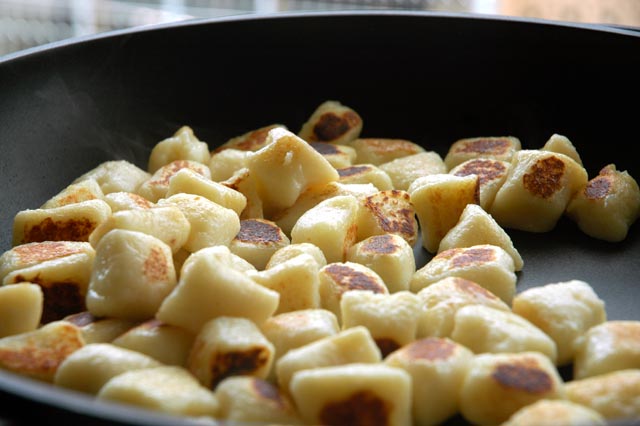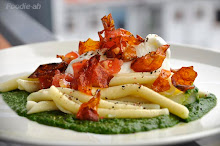A Saturday lunch at home with a gourmet craving... the only solution is to try something new that can satisfy the culinary libido!
This meal was inspired from ideas shown on "Cook like a chef - Season 3", on the Asian Food Channel. I highly recommend this programme to anyone who loves cooking.

As you would expect from any true Italian, I love making fresh pasta. I like the uneven, rustic texture that you can enjoy only with homemade egg pasta. For this recipe, I used 3/4 of regular flour and 1/4 semolina flour to obtain the texture shown on the picture. Apart from that, I followed the classic recipe, with 1 egg for each 100gr of flour. Once the dough is ready and rested, flatten it as you would normally do, lay it on the worktop and randomly position fresh herbs on one half of the strip of dough (try to discard the stems as they tend to break through the dough). Fold it and press the top to stick it to the other side, trapping the herbs in between while making sure you don't create air bubbles by pressing from the middle and moving outwards. Proceed with the pasta machine once again, thinning the layer to taste. I like to make this slightly thicker (about 7 out of 9 on my pasta machine) for this particular dish. Once done, roughly cut the layer into big squares (about 10cm long) as if you were making lasagna.
The herbs I used were red basil, dill and parsley. Other herbs can work and look as beautiful.

This fresh mozzarella roll is a great, quick appetiser. Peel 2 tomatoes, remove the seeds, chop them and salt them. Cut 2-3 mozzarella's into about 4-6 pieces each, and drop the pieces into hot water (bring the water to about 70-80 degrees). Leave the chunks in the water for about a minute, until it's softened, then remove them and rapidly arrange them on a piece of cling film. With your hands, mould the mozzarella into an even square and top with fresh basil leaves and cubes of tomatoes. For extra flavour, you could also lay a slice of Parma ham. Finally, roll the mozzarella and wrap it with the cling film. Store it into a fridge for an hour or so, until firm and ready to slice at a slight angle. I decorated this dish with some strips of fried, crispy raw ham (Parma ham or similar), and a few drops of olive oil.

Coming back to our pasta... time to make the sauce. This is probably the easiest way of making a tasty tomato sauce. Position 2-3 halved tomatoes and 2-3 halved shallots on a baking tray. Grill them in an oven at 200-250 degrees until they are well melted and dried and the surface shows signs of burning (30-50 minutes). Those burnt bits really add to the flavour! Remove from the oven, and put them all into a blender. Mash to taste, fry some bacon on a large pan, and once ready pour the tomato mixture into it, together with a few leaves of fresh basil. Season with salt and a bit of olive oil or butter to taste, and simmer until your pasta is ready.
Boil the pasta sheets (less than a minute will be enough), and position them on top of the sauce. Top with some grated Parmesan and serve.

To prepare this beef fillet with herbs, make a French vinaigrette by mixing 3 parts of extra virgin olive oil with one part of wine vinegar. Add some finely chopped shallots and herbs to taste (I used dill, red basil, chives and parsley). Add a spoon of Dijon mustard, salt and pepper and stir with a whisk. Let the vinaigrette rest while coarsely chopping the same herbs to create a herb salad. Pour some of the condiment on the salad and gently toss it. For a smoother flavour, the vinaigrette could be made far in advance.
Thinly slice a couple of potatoes, fry some butter and oil on a large pan and arrange the potato slices on top. Cover and let them cook over medium-low heat until the bottom is golden brown.
Cook the fillets of beef to taste, salt them and arrange them on a bed of sliced potatoes, top with the herb salad and drizzle with some extra vinaigrette.
 I suggest for this recipe that you mix 70% of plain flour with 30% of wholemeal when you make the dough. As usual, 100gr of flour for 1 whole egg, a little salt and a dash of olive oil. Mix the flour with the egg, salt and olive oil, kneed the dough for about 5 minutes and let it rest for 30-40 minutes.
I suggest for this recipe that you mix 70% of plain flour with 30% of wholemeal when you make the dough. As usual, 100gr of flour for 1 whole egg, a little salt and a dash of olive oil. Mix the flour with the egg, salt and olive oil, kneed the dough for about 5 minutes and let it rest for 30-40 minutes. Finally, flatten the dough into pasta sheets, preferably thicker than usual (probably a 5-6 on your pasta machine) and cut them with a kitchen knife into irregular shapes.
Finally, flatten the dough into pasta sheets, preferably thicker than usual (probably a 5-6 on your pasta machine) and cut them with a kitchen knife into irregular shapes. To make the sauce, I used Parma ham instead of pancetta as I am unable to find pancetta in Singapore. Unfortunately using Parma ham is an expensive alternative, but you can use the cheapest raw ham that you can find (Serrano or similar).
To make the sauce, I used Parma ham instead of pancetta as I am unable to find pancetta in Singapore. Unfortunately using Parma ham is an expensive alternative, but you can use the cheapest raw ham that you can find (Serrano or similar).


























